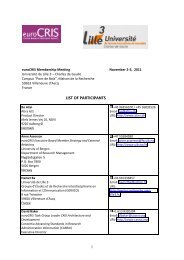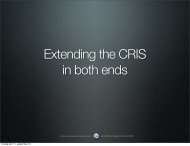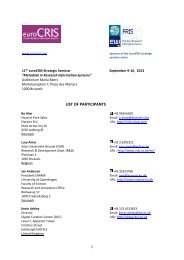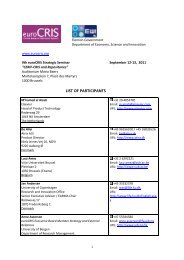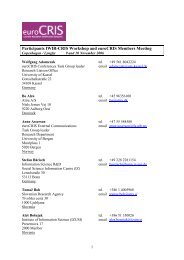Paper - EuroCRIS
Paper - EuroCRIS
Paper - EuroCRIS
Create successful ePaper yourself
Turn your PDF publications into a flip-book with our unique Google optimized e-Paper software.
Berkhoff, Karin; Ebeling, Britta; Lübbe, Sven: Integrating research information into a software for higher education<br />
administration – benefits for data quality and accessibility. In: Jeffery, Keith G; Dvořák, Jan (eds.): E-Infrastructures for<br />
Research and Innovation: Linking Information Systems to Improve Scientific Knowledge Production: Proceedings of the 11th<br />
International Conference on Current Research Information Systems (June 6-9, 2012, Prague, Czech Republic). Pp. 167-176.<br />
ISBN 978-80-86742-33-5. Available from: www.eurocris.org.<br />
ly, they may want to document the complete process as a basis for later reports and publications.<br />
The HISinOne web-based technology and the community function allows for the real time communication<br />
and exchange with participants inside and outside the university.<br />
The final phase of a research process is called the “Output” phase. Reports of research results and<br />
proofs of utilization of funds have to be created for the funding agency. Again, for standard funding<br />
procedures special template can be created and automatically pre-filled with the relevant project<br />
data.<br />
Research output is produced in the form of publications or reports. Interfaces to libraries and<br />
usage of standard formats allow for an easy import or export of new publications. Publications are<br />
entered into the system only once, either into the HISinOne system or in the library system of the<br />
university. Publication and project data can be reused in another context, e. g. for a researcher’s<br />
CV or for the university website, to present research activities and output. Several research specific<br />
(statistical) analyses and reports can be generated to evaluate the research activity and output.<br />
They can be combined with additional data from campus and resource management, e. g. to improve<br />
resource allocation or decision support at the administration level. The CERIF standard is<br />
strictly followed by HISinOne-RT to ensure an easy exchange of research data.<br />
3 Benefits of the integrated approach<br />
The example of HISinOne-RT demonstrates that there are some additional advantages of the<br />
integrated approach over standalone CRIS or RMS systems. Mainly, the RT segment can benefit<br />
from all advantages of the new IT standards of HISinOne without the need of interfaces. The RT<br />
segment not only provides a complete research workflow support, but it is also integrated and<br />
balanced with the other workflows of campus and resource management. Furthermore, in the<br />
common data base all essential information is available without data transfer and thus avoids<br />
redundancy. For example, the full integration into a campus and Research Management System<br />
allows generating statistical analysis with the same business intelligence engine. The reports have<br />
the same design, can be generated in the same way and may include data from other segments.<br />
The users do not have to switch between software applications. Information access is controlled<br />
by a comprehensive role and rights and a view concept, which guarantees only authorized data<br />
access. Due to its flexibility and customizing options, HISinOne is equally suitable for small universities<br />
and large universities. It can handle centralized organizational structures as well as decentralized<br />
structures.<br />
Due to the cross-sectional character of research management and information, many already implemented<br />
functions of other segments can be reused by the RT segment (e. g. business intelligence<br />
to generate reports and statistics, the community function to keep in touch with other researchers,<br />
interested persons or cooperation partners). Also information of the RT segment can be<br />
reused in other segments, like the personal research profile, current projects or publications.<br />
The HISinOne “Portlet” function allows for individual configuration of the project management<br />
cockpit, to keep a comprehensive overview of the current project state. This individual overview<br />
can also be combined with data from other software segments, depending on the different roles of<br />
the user within his university. Thus, the user can customize a complete individual information<br />
cockpit for efficient management and enhanced decision-making. A reminder function for relevant<br />
time lines and tasks of research, campus and resource management is available. Also external<br />
This work is licensed under a Creative Commons Attribution-NoDerivs 3.0 Unported License. 8



